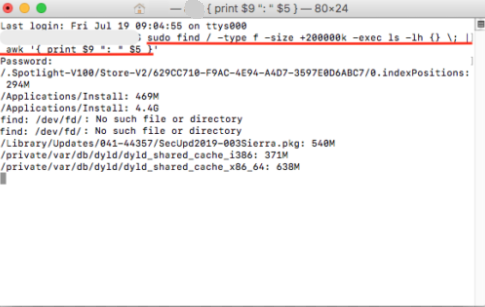
- #Find large files on mac full#
- #Find large files on mac free#
- #Find large files on mac mac#
- #Find large files on mac windows#
There is one important thing to keep in mind when using Disk Inventory X, though. There’s also a tree view on the sidebar that lets you see how much space every folder takes up, and you can drill down to find the files you might want to delete. You can right-click each file to move it to the Trash or view more info about it. Click any square to view the associated file name. You can see which sections are taking up the most space by which squares in the visual display are the largest.
#Find large files on mac free#
Use a Third-Party Tool For Even Better Controlĭisk Inventory X is an excellent free tool for visualizing disk space.
#Find large files on mac mac#
You can use it to configure iCloud storage and set your Mac to empty the Trash automatically, for example. The Storage Management app has some other useful tools, as well.
#Find large files on mac full#
The Finder only shows single files over a certain size, not folders full of smaller files, such as Downloads or program installs.However, there are two drawbacks to this method: You can then choose which ones you want to delete. Type in the minimum file size you want to search for (over 100MB or so will do the trick) and you’ll see a list of all files over that size. You can then use the drop-down menus to select the “File Size” and “Greater Than” options. Click the drive you want to search, open the search window, and hit the + button next to the “Save” button at the top right. Find Large Files Manuallyįinder has a built-in way for finding large files with Spotlight search. The Trash folder in macOS also can take up quite a bit of space if you haven’t emptied it in a while, so it’s worth taking a look to see if you’re still storing some large files. That folder is located here: ~/Library/Application Support/MobileSync/Backupĭepending on how big your device is, and how often you back up, these backup files can take up tens of gigabytes.

One such place that can take up a lot of space is the folder where iTunes saves backups of your iPhone or iPad. The Downloads is one of them, and a lot of people fill it up and forget to empty it, but files are hiding in places you wouldn’t expect. If you like GrandPerspective then you might also be interested in Disk Inventory X and WhatSize.Most of your files will only be in a couple of folders. It’s a fantastically quick and intuitive way to find those giant files that are sucking up your disk space. GrandPerspective has a few other features and options, but overall it’s a simple app that does one job well. If you want to find out the sizes of enclosing folders rather than individual files, use the Focus buttons in the toolbar to change folder levels (or press Command-).

Also, should you so desire, you can zoom in on really small files by using the Zoom buttons in the toolbar, or by pressing Command-+ (plus) or Command- – (minus): If the view is all a bit overwhelming, you can click the Edit button in the Display tab to display only certain types or sizes of files. You can change this by clicking the Drawer icon, then the Display tab, and choosing an option for Color by:

By default, files in the same folder are given the same colour. Rectangles are grouped together by folder, making it easy to find stuff in the same folder. Deleting is disabled by default (it’s easy to delete more than you mean to), but you can enable it in the prefs. Click a file to select it, then you can open it or reveal it in the Finder using the toolbar buttons.
#Find large files on mac windows#
You can see that my Parallels Windows XP virtual hard disk is taking up the most space, at 9.53 GB. Hover over a rectangle to see the file name and size in the status bar. The bigger the rectangle, the bigger the file. Here are all the files on my hard disk:Įach file is represented by a rectangle. You then see a visual representation of all the files. You can choose a folder, or click your hard disk icon to scan the whole disk:Ĭlick Scan, and GrandPerspective reads all the files and folders (including subfolders) in your selected folder – this can take a few minutes.

When you open the app it asks you for a folder to scan. GrandPerspective is a free app that gives you a graphical representation of all the files and folders on your hard drive (or in a specified folder), using a clever technique known as treemaps. However, I recently came across a better way to find big files. Obviously deleting a few big files is less effort, which is why this Finder trick is useful. That meant I needed to delete some files – either a lot of small files, or a few big ones. I recently ran out of disk space on my iMac (I regret buying the 250GB hard drive model and not the 500GB!).


 0 kommentar(er)
0 kommentar(er)
